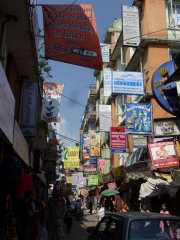Sight-seeing in Kathmandu is an endurance sport. The whole city is clogged with motorbikes, pedestrians, tiny Suzuki taxis and other random obstacles, which might be okay if the roads weren’t barely one lane wide with shops and street pedlars spilling out onto them. Crossing a road is like walking across the dodgems ride at a fairground. And the bikes and the taxis go beep beep beep beep BEEP beep beep beep beep beep BEEEEEEEP beep beep BEEP beep beep all day long. If you decide to take a taxi instead, you typically have to try three before finding one who won’t insist on trying to overcharge the tourist even though you’ve made it clear that you know what the going rate is for that journey.
The smog is atrocious in the streets; it took about an hour for us both to develop a bit of a cough, and after a couple of days my eyes are hurting. I have never been anywhere more polluted, and can’t begin to imagine what it does to the life expectancy of the poor sods who live and work here, many of whom sit at their street stalls with handkerchiefs pressed to their mouths and eyes half-shut. Kathmandu is surrounded by mountains – but you can’t actually see them through the soup! We’ve crossed several rivers, the banks of which are mountains of trash and the channels essentially sewers. The locals’ habit of just dropping rubbish in the street wherever some rubbish has already been dropped could also do with changing.
The one redeeming feature of Thamel, the tourist district, is that the streets are a tiny bit less insane than elsewhere. But otherwise it’s a typical tourist area teeming with shops selling handicrafts and knock-off trekking equipment, cheap guesthouses and restaurants offering pizza and chips. Kathmandu was apparently a really good place for a traveller to just hang out and relax a while, but the only way to relax here is to stay in your hotel room or a good cafe you know.
I need to balance my bile with some positive points.
- Everything is very cheap, a good meal for two could be £5 to £15 and they cleaned the sensor of the annoying little camera for £20 where the same cost £30 in Cape Town.
- I also have an inordinate fondness for the national drink, milky masala tea just like in India and here only 25p. On reflection, I haven’t had a single cup of coffee here.
- Another comparison with India, the touts and guys who want to be your guide are more polite and less parasitic here. Indeed, their tactic often seems to be the sob story – “I’m a guide, but I haven’t found anyone yet to guide today and so I have no money”. Hmm. You can’t be a very good guide then, can you?
- The best things we’ve seen are the Swayambuna stupa, the village of Bungamati and the Durbar Square in the neighbour city of Patan – though all outside of Kathmandu proper.
- And all the Nepalese we’ve met have been friendly and (attempted to be) helpful.
Probably the most positive point is our host at the Dolphin Guesthouse, Surendra. He’s been incredibly helpful, and took me out to find the camera repair place (up a back staircase in the shady interior of an unmarked building – not somewhere I’d find myself!) as well as providing lots of useful advice. Our room is small but okay, though the bathroom is intended for a contortionist as the loo is situated where you would want to stand in front of the sink.
Kathmandu: it’s polluted, frenzied, unappealing and exhausting. Let’s dub it the “gateway to Nepal” and hope the rest of the country is better.
Related Images:

















































lol, yeah you’ve really sold it there, after going pea green over your Madagascar exploits this made me feel better so thanks. You should have brought your stormtrooper respirator suit after all it seems…
We’re staying in Bhaktapur now, a city merely 12km from Kathmandu and (to paraphrase the guidebook) it really is just like Kathmandu would have been two decades ago. So that’s a hot tip if you ever do come to this part of the world – stay in Bhaktapur, day-trip to Kathmandu for the sights.